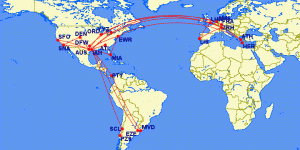The 16th International Semantic Web Conference took place from October 21-25 in Vienna, Austria. These are my random thoughts.
First of all, I’m honored to be part of the Organizing Committee as a chair of the In-Use Track, together with Philippe Cudré-Mauroux. Jeff Heflin was the General Chair and a fantastic leader. The conference was impeccable thanks to the AMAZING local organization. Axel Polleres and Elmar Kiesling did an incredible job. I truly enjoyed every step of the process to help organize ISWC 2017. I am really looking forward to ISWC 2018 in Monterey, CA and ISWC 2019 in Auckland, New Zealand!
I was part of a pre-ISWC meeting which a followup with the group that attended the Dagstuhl workshop on Federated Semantic Data Management. We continued defining a list of prioritized research topics.
A pre #iswc2017 meeting on Federated Semantic Data Management pic.twitter.com/WoCJGQUEoJ
— Juan Sequeda (@juansequeda) October 20, 2017
Frank van Harmelen gave a fantastic keynote at the Semantic Science workshop about the end of the scientific paper.
Slides of my talk at Semantic Science workshop at #ISWC2017https://t.co/6lX1v4vYE3 : two talks in one, on pro;s&cons of nanopublications
— Frank van Harmelen (@FrankVanHarmele) October 21, 2017
Btw, if you have the chance to see Frank give a talk… it’s a must! He is one of the best speakers in academia that I have ever seen. I wish I could present like him!
Fantastic talk by @FrankVanHarmele on the end of the scientific paper #iswc2017 pic.twitter.com/UmiXI5tQJh
— Juan Sequeda (@juansequeda) October 21, 2017
I attended most of VOILA!2017 Workshop. The highlight of the event was the demos. Around 20.
* Next version of VOWL is addressing a lot of needs.
* Check out ViziQuer. It looks cool but I’m skeptical about how usable it is.
* Great to see interest on UIs for generating R2RML mappings but they haven’t been tested yet with real world scenarios. Long ways to go here.
* I need to check out the Linked Data Reactor
* Treevis.net, interesting resource. Need to check it out.
* The extensible Semantic Web Browser
* user, user, user: everybody mentions users but usually the “user” is not defined. Who exactly is your user?
Welcome ceremony was in the Vienna Rathaus. Beautiful place. We were so lucky.
During the welcome ceremony, we had reencounter of 5 alumni from the 2008 Summer School on Ontological Engineering and Semantic Web: Laura Drăgan, Tara Raafat, Maria Maleshkova, Anna Lisa Gentile and myself with John Domingue and Enrico Motta who were the organizers. We have gone a long ways!
Great discussion about the history of Project halo funded by Vulcan with Michael Witbrock, Oscar Corcho and Steffen Staab. Learned a lot of historic details.
Congrats to Mayank Kejriwal for winning the 2017 SWSA Distinguished Dissertation Award! Mayank and I are academic brothers: we both did our PhD at the University of Texas at Austin under the supervision of Prof Daniel Miranker.
Congrats to DBpedia for winning the SWSA Ten-Year Award. Definitely well deserved!
10 years of DBpedia! Wow!! Congrats #iswc2017 pic.twitter.com/A1fvAikJ88
— Juan Sequeda (@juansequeda) October 23, 2017
Industry and In use: If I’m not wrong, approximately 25% of attendees of ISWC were from industry and government (more specifically not from academia). All the industry talk were on Monday. Great to see the room full all of the time. We are definitely seeing more use of semantic technologies. However, my observation is that this is mainly government and research/innovation folks are very large companies. It is not yet replacing the status quo. Additionally, a lot of complaints about the lack of maturity of tools, specially open source tools. I’m not surprised.
Ontology engineering seems to be popular (or it never stopped?). Deborah McGuinness‘ keynote showed real world projects in health care where ontologies play a central and vital role. Takeaway message: it takes a village.
@dlmcguinness highlights our collab to identify cancer drugs from a probabilistic knowledge graph https://t.co/qLYEAK5qi4 #iswc2017
— Michel Dumontier (@micheldumontier) October 23, 2017
It seems to me that we have had the following evolution in the past decade: first focus on hard core theoretical ontologies (DL and the like), second focus has been more on the data side (Linked Data), third focus (now) is about “little semantics goes a long way”. Jim Hendler has always been right (see my comments below on Jamie Taylor’s keynote).
Is this the year of the Knowledge graph? Are Knowledge Graphs becoming Mainstream? Thomson Reuters announced (by coincidence?) their Knowledge Graph while ISWC was going on. There was no formal announcement during the conference.
Thomson Reuters Launches first of its kind Knowledge Graph Feed. https://t.co/D7OoSpuESX
— Geoffrey Horrell (@GeoffHorrell) October 23, 2017
Interesting part is that Thomson Reuters built their own RDF graph database (triplestore). Why? See this tweet:
If you are at #iswc17 @nonodename can explain. Usual issues of scale, security, cost and business features – especially write speeds.
— Geoffrey Horrell (@GeoffHorrell) October 24, 2017
I presented a poster on the Ontology and Mapping Engineering Methodology that we have been using at Capsenta in order to apply semantic web technologies to address data integration and business intelligence pain points. THANK YOU THANK YOU THANK YOU for all the feedback that I received during the poster session and hallway conversations. This is the reason why you go to a conference! Special shoutout to Enrico Franconi and Frank van Harmelen. Conversations with you were extremely insightful.
Interested in #DataIntegration #BusinessIntelligence #ODBA #R2RML #Mappings #Ontologies #Methodology #Capsenta #Ultrawrap find P34 #iswc2017 pic.twitter.com/DQPMa9MX28
— Juan Sequeda (@juansequeda) October 23, 2017
Jamie Taylor, the former Minister of Information at Freebase (and the person who has had one of the coolest titles) and who now manages the Schema Team for Google’s Knowledge Graph gave the third keynote, which btw, was exactly what you expect for a keynote. Thanks Jamie for such an awesome talk!
Jamie Taylor from Google is the #iswc2017 Wednesday keynote pic.twitter.com/vyui4G31dm
— Juan Sequeda (@juansequeda) October 25, 2017
His message was very clear: we need actionable and executable Ontologies/Knowledge Graphs. What does this actually mean? The example he gave was the following: in the Google KG, they have assertions that Polio and the Vaccine for Polio, but no where it is asserted that the Vaccine for Polio prevents Polio. This goes into adding common sense knowledge (think about Cyc). I think it would be fair to say that the lessons learned reported by Jamie were a bit “duh”/“told you so” to this community. My observation is that the giant Google, at the end, is doing what the Semantic Web community has been working on for over a decade. This is good! It was very nice to see the evolution of the Knowledge Graph at Google and insightful to see the practical role that semantics take place. Pascal Hitzler quickly wrote up his take away from Jamie’s keynote.
Congrats to Olaf Hartig, Ian Letter and Jorge Perez for winning the Best Paper Award.
The Chilean mafia continues!!! @olafhartig @perez win the Best Paper Award! #iswc2017 @ciwschile pic.twitter.com/hWFdLIjoYN
— Juan Sequeda (@juansequeda) October 25, 2017
This paper presents foundational work towards understanding what are Linked Data Fragments (LDF) and the relationship between different types of LDF. From a more general point of view, this work helps to formalize the relationship between a Client-Server architecture. Hence it’s applicability is not just within the Semantic Web. This is a beautiful example of how theory and practice can be bridged. Additionally, the presentation was simply brilliant. Jorge Perez has the capability of taking the most complicated concepts and presenting them in a way which is understandable and enjoyable to the audience. I can’t wait to see this presentation on video lectures. When it is published, this is a must see on how to present a paper at a conference. I wish I could present like Jorge!
Check the slides of my talk about Linked Data Fragment Machines at https://t.co/G5m9JDtWs2 And come to see the talk, next session! #iswc2017
— Jorge (@perez) October 24, 2017
Daniel Garijo presented his WIDOCO tool. If you work with ontologies, you really need to use this tool which basically is an outsource for the documentation of the ontology. He also received the Best Paper Award for the Resource track. Well deserved!
Outsource the documentation of your Ontology to WIDOCO, thanks to @dgarijov #iswc2017 pic.twitter.com/SgVp9L9bCc
— Juan Sequeda (@juansequeda) October 23, 2017
You can find all the papers of the conference for download on the ISWC 2017 website. No paywall!
The Job Fair was a great addition. Looking forward to seeing its evolution in the upcoming ISWC.
I really enjoyed being part of the mentoring session. It’s great to hear students about what worries them and provide some advice. We discussed paper publishing process, academia vs industry, US vs Europe, dealing with loneliness, and many more topics. Please reach out if you have any questions!
Great mentoring lunch for @oeg_upm PhD students @albafizq @mnavas314 @dchavesf. Thank you very much @juansequeda @VTamma
— David Chaves (@dchavesf) October 24, 2017
Great to have more Austin presence at ISWC with data.world
Austin, Texas presence at #iswc2017 @bryonjacob presenting @datadotworld pic.twitter.com/7OU1jbHe7h
— Juan Sequeda (@juansequeda) October 23, 2017
who also sponsored the … JAM SESSION! All I can say is:
My research community is cooler than yours! Jam session by PhDs in Computer Science #SemanticWeb #iswc2017 pic.twitter.com/RoMMXp6ndB
— Juan Sequeda (@juansequeda) October 23, 2017
and without further ado, here is 1+ hour video of the Jam Session, a large group of Semantic Web Computer Scientist PhDs jamming, after just 3 hours of practice. I think this is the definition of epic! Enjoy!

